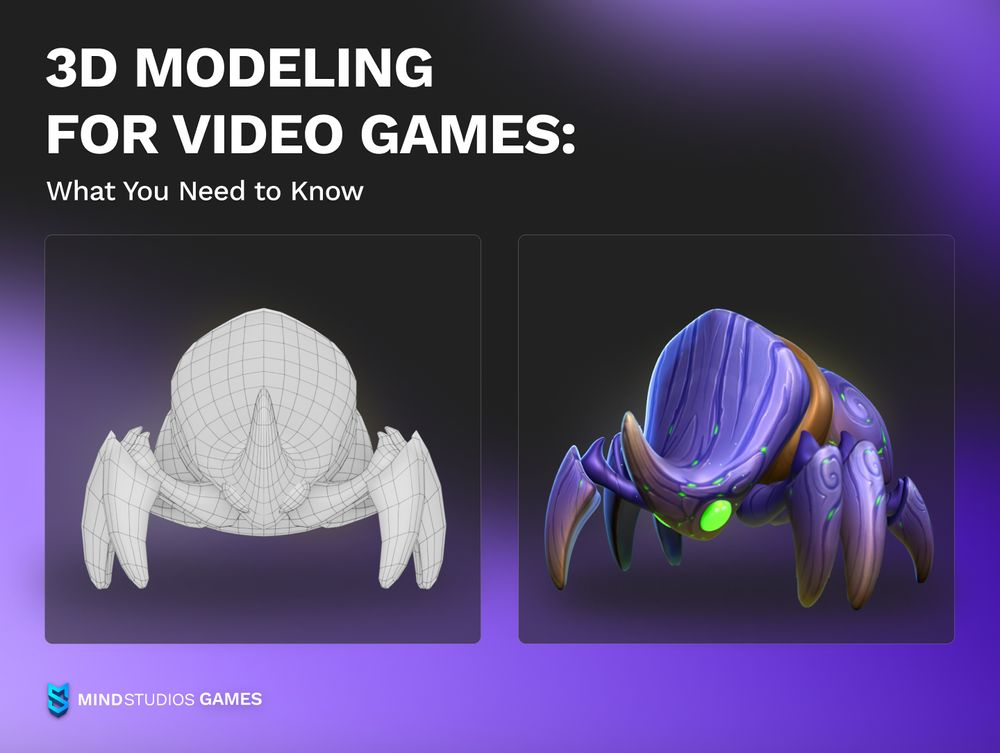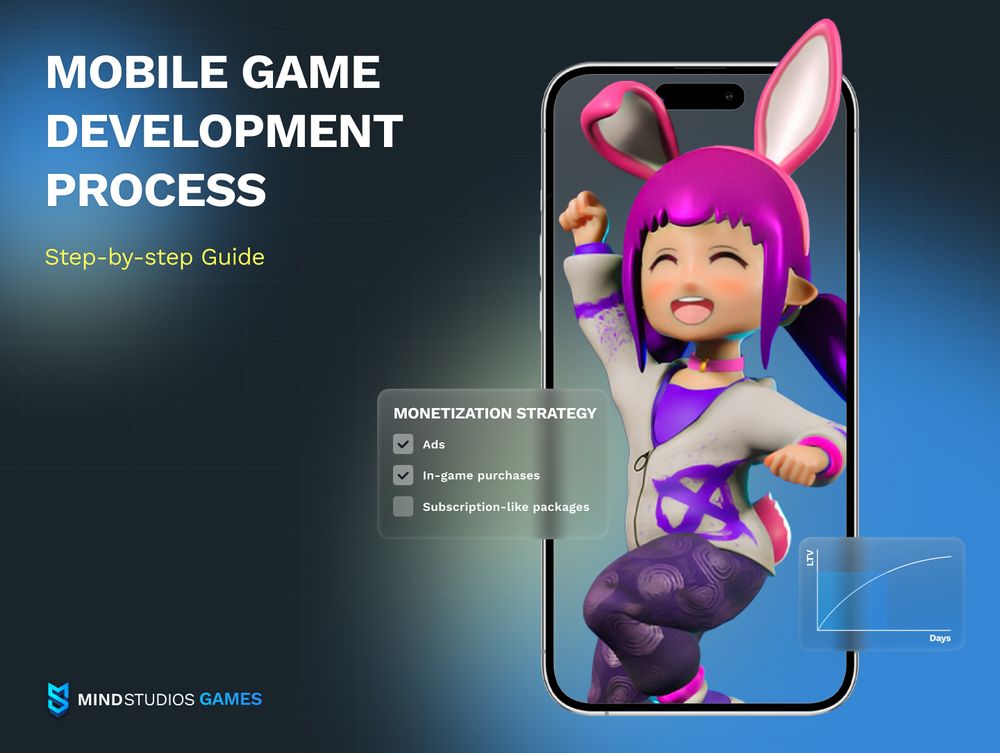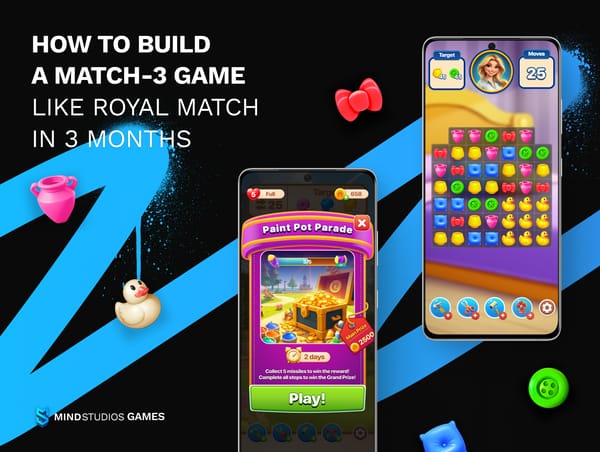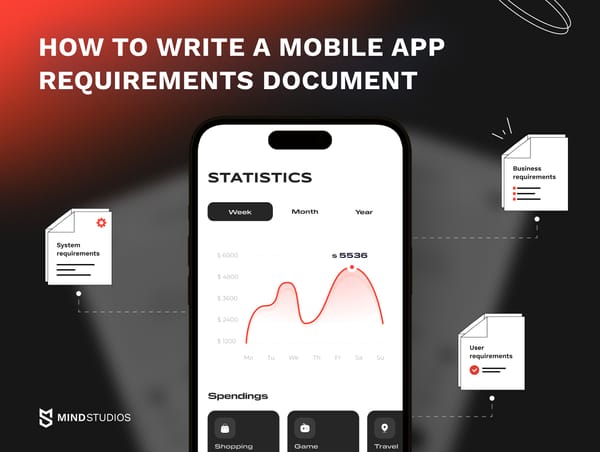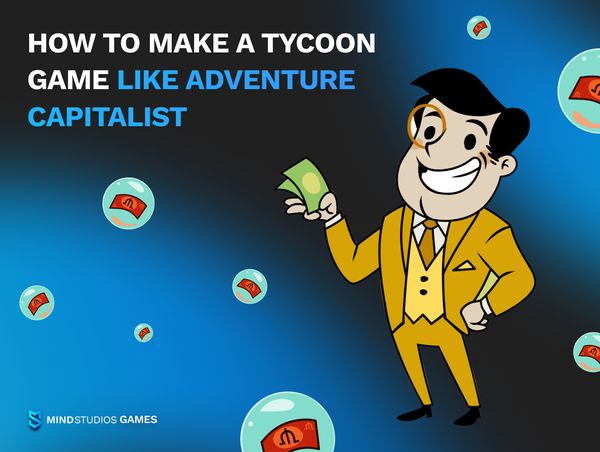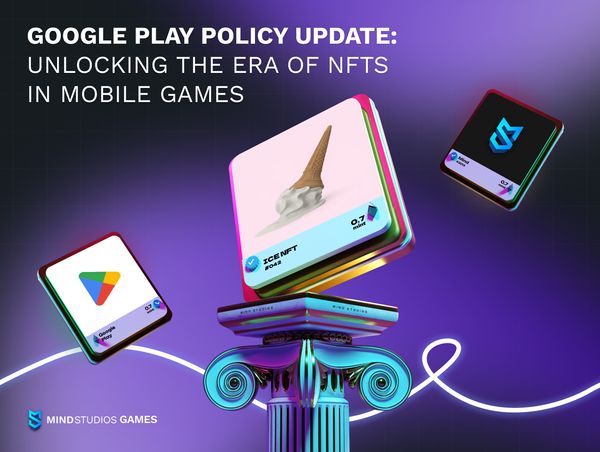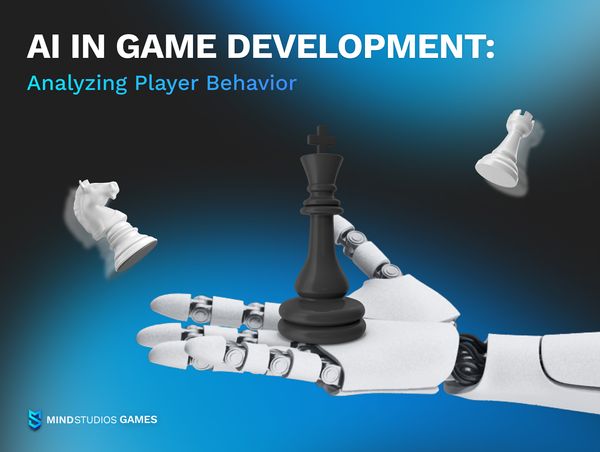Turn-based game development is on the rise these days. Why? Well, in the rapidly evolving mobile gaming industry, turn-based games have carved out a niche of their own, offering a blend of strategic play, engagement, and accessibility that appeals to a broad spectrum of players. These games, characterized by their structured play sessions and tactical depth, not only captivate players but also promote sustained user engagement and monetization opportunities.
Turn-based games have also, for the longest time, been the option to replace action and adventure PC/console games that were “too heavy” for mobile devices. After all, these types of games don’t have a problem of “I lost to the monster because my phone can’t handle the graphics/mechanics and my connection is slow.” Players can take time to make a move and that won’t affect the outcome.
Currently, at Mind Studios Games, we’re working on several games that can be described as turn-based.
Here’s how our game designers describe turn-based titles they’ve played and worked on:
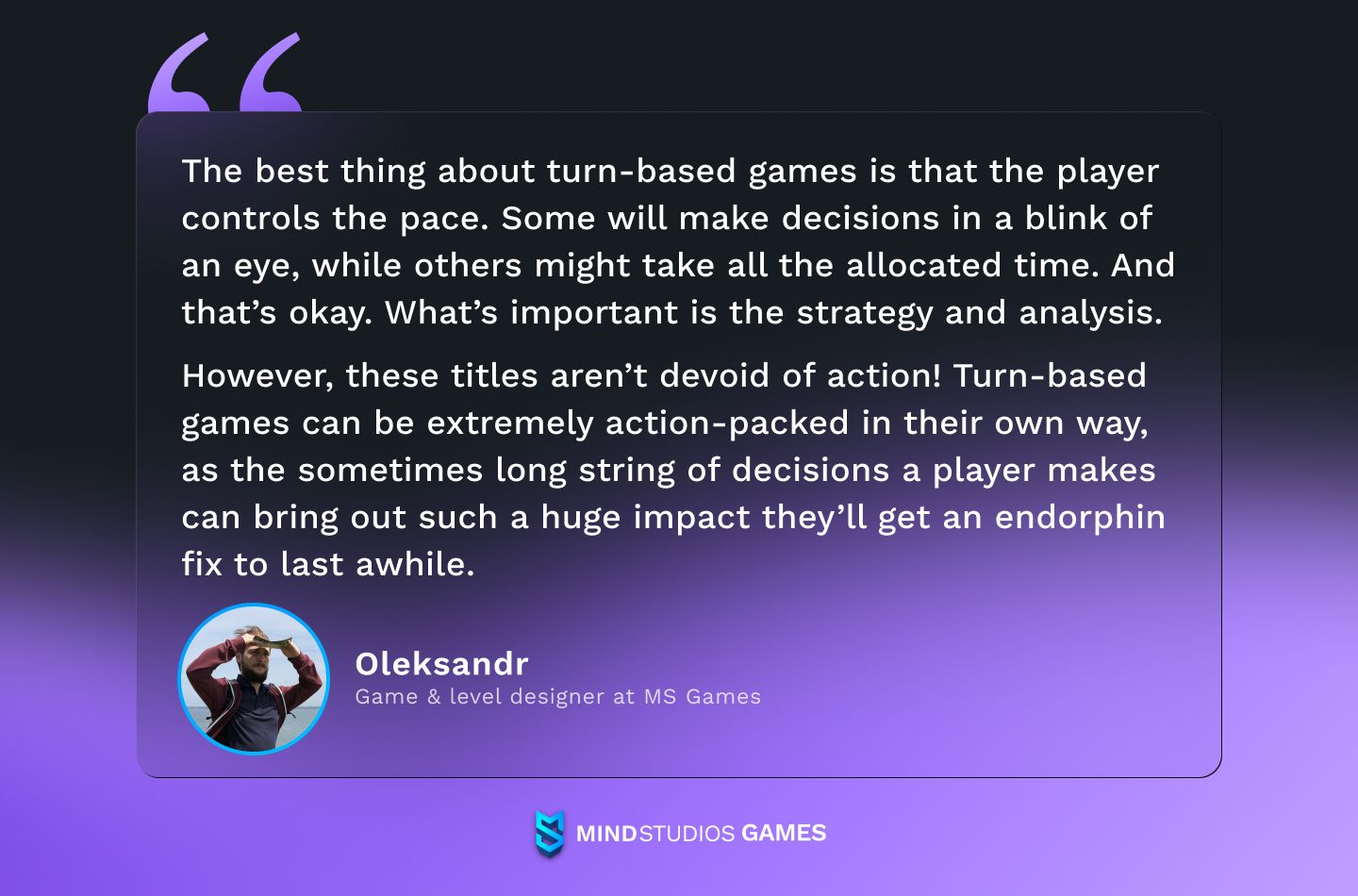
In this article, we’ll share our knowledge on how to make a turn-based game, from the moment an idea popped into your mind and till the launch and beyond. We’ll cover the genres popular among turn-based games, the challenges in designing an engaging game of this type, and provide some insights into current trends. Read on if that’s something you’ve been looking for.
Key takeaways:
- Turn-based games can exist in multiple genres and types;
- The process of turn-based game development is similar to developing other games, but has unique challenges;
- The biggest challenge for game designers in turn-based games is to achieve a balanced pacing suitable for different players;
- Depending on whether the game is single-player or multiplayer, the approach to turn-based game development will be different.
Genres and types of turn-based games
Just like any other representative of the gaming industry, turn-based games cover a wide variety of genres and types, each offering unique gameplay mechanics and experiences and captivating players in its own way.
The main of these genres and types are the following.
Turn-based auto-battlers
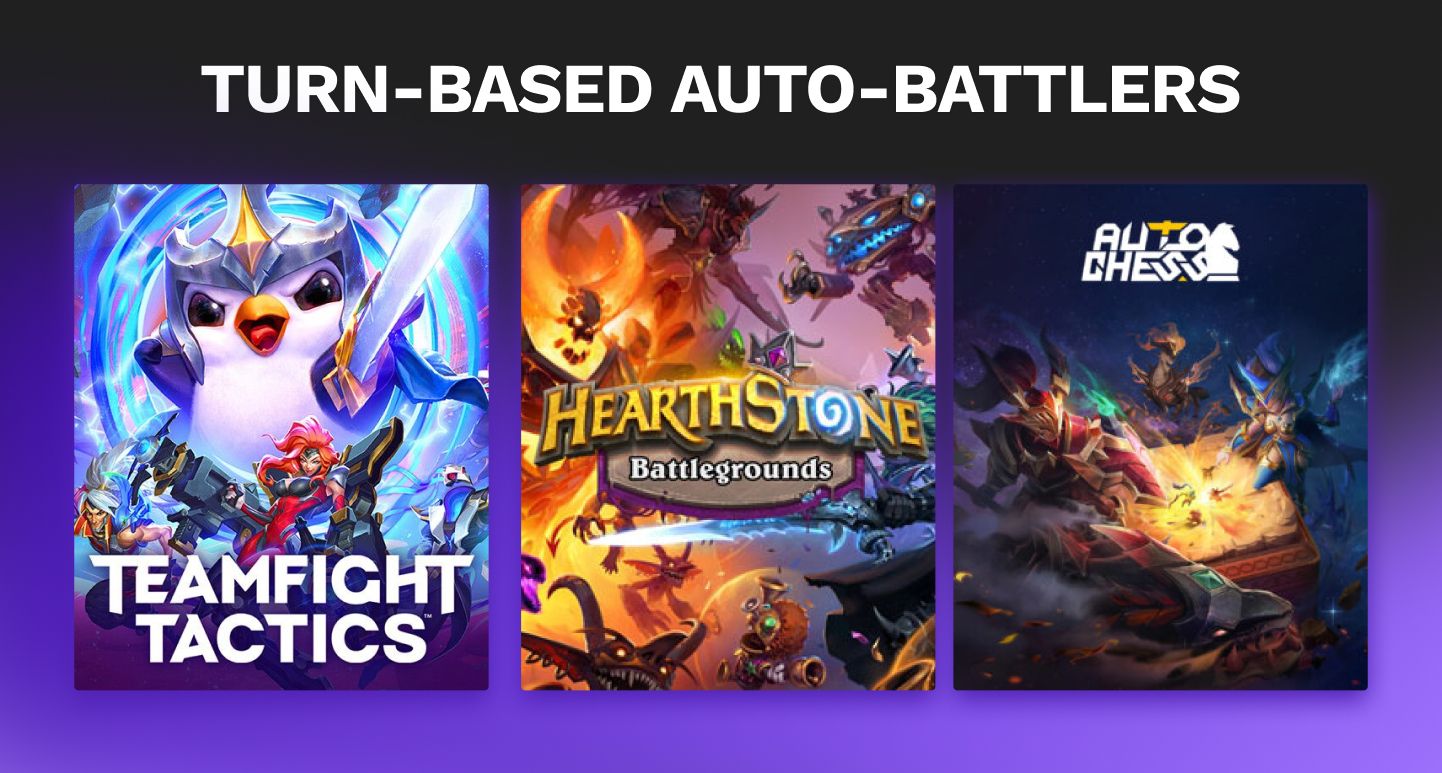
Also known as auto-chess games, auto-battlers require players to focus on whom to choose for a particular battle from their deck/team and how to place them on the board. After that, the battle is controlled by bots, and the player only watches to see if their strategy worked and how the opponent plays. In this genre, character combinations and their synergy play the leading role.
A game mode for Dota 2 called Dota Auto Chess was the trend setter for this genre, and other popular titles would include Hearthstone's Battlegrounds mode and Teamfight Tactics, a spin-off of League of Legends.
Turn-based RPGs (Role-Playing Games)
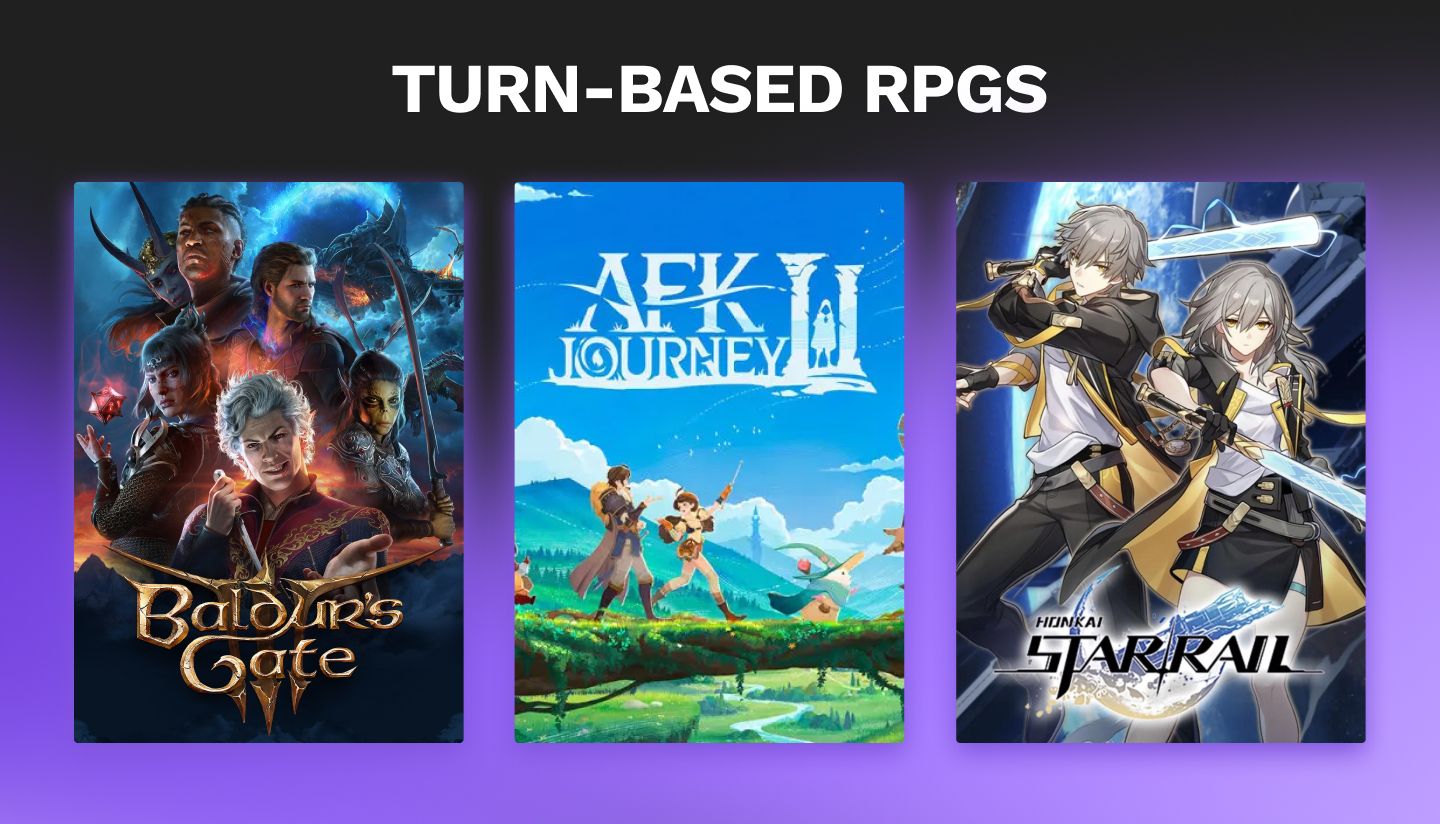
In this type of game, the player is responsible for character development. The choices they make shape their character, abilities, and journey, and the more complex the game is, the more options they have to influence the character's story. These games have roots in classic tabletop RPGs.
They also generally offer strong combat mechanics and encourage you to build and improve teamwork within your squad. Some of the latest and widely acclaimed turn-based RPG titles are Baldur's Gate 3, AFK Journey, and Honkai: Star Rail.
Turn-based Tactics (TBT)
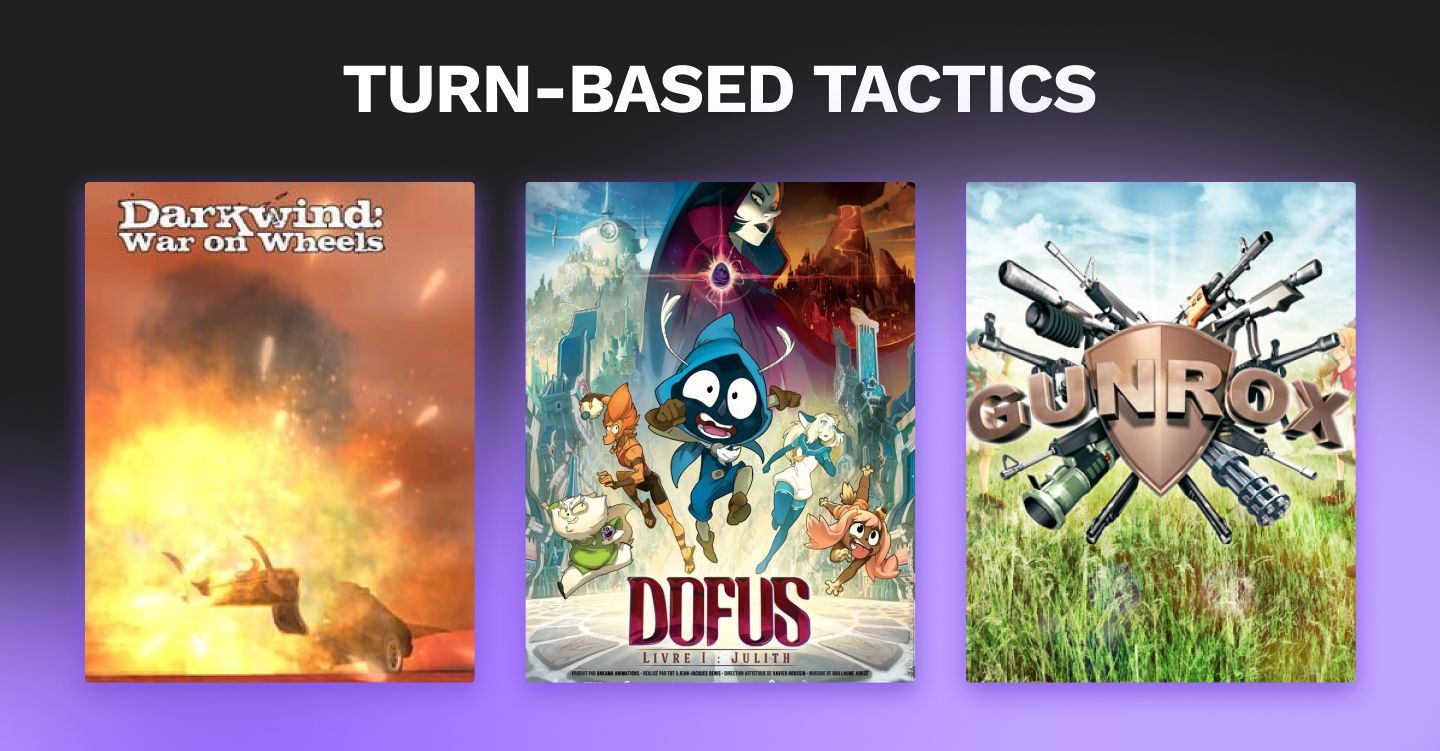
Also known as tactical RPGs, these games are inspired by military tactics and operations. They allow players to create and implement their own strategy and complete tasks using only the units or squads provided to them. Basically, the player's goal is to outmaneuver the opponent with the resources and troops they have.
Titles like Dofus, Gunrox, and Darkwind: War on Wheels are vivid examples of turn-based tactics games. Among desktop titles, Xcom, Wasteland, and Darkest Dungeon come to mind.
Turn-based Strategy (TBS)
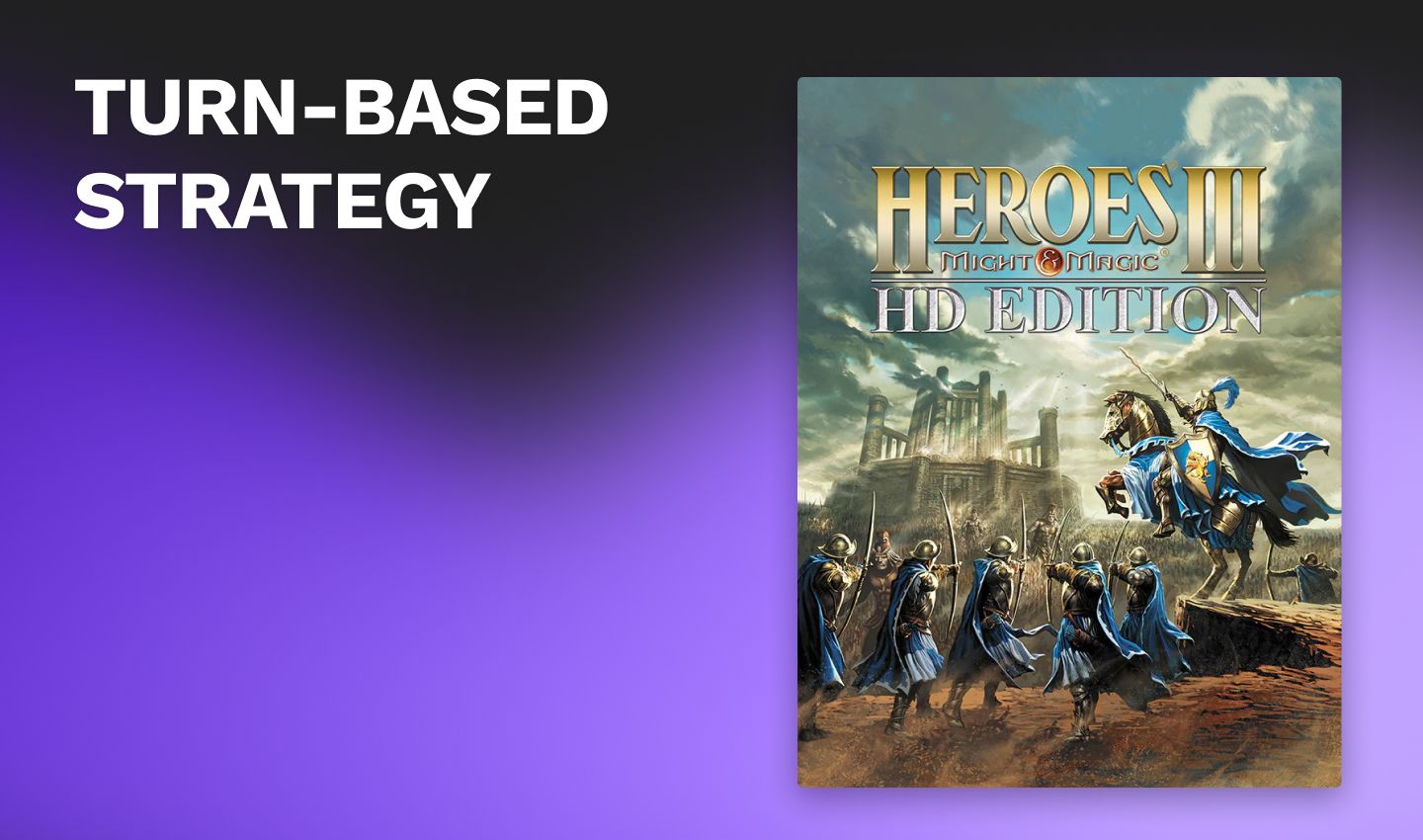
Turn-based strategy video games are similar to TBT ones. However, in this case, the players have to focus on larger-scale strategic planning and resource management. They need to take turns with other players to build and expand their empires, manage resources, and engage in war battles.
Old but gold game Heroes of Might And Magic is one of the best examples of TBS.
4X strategy
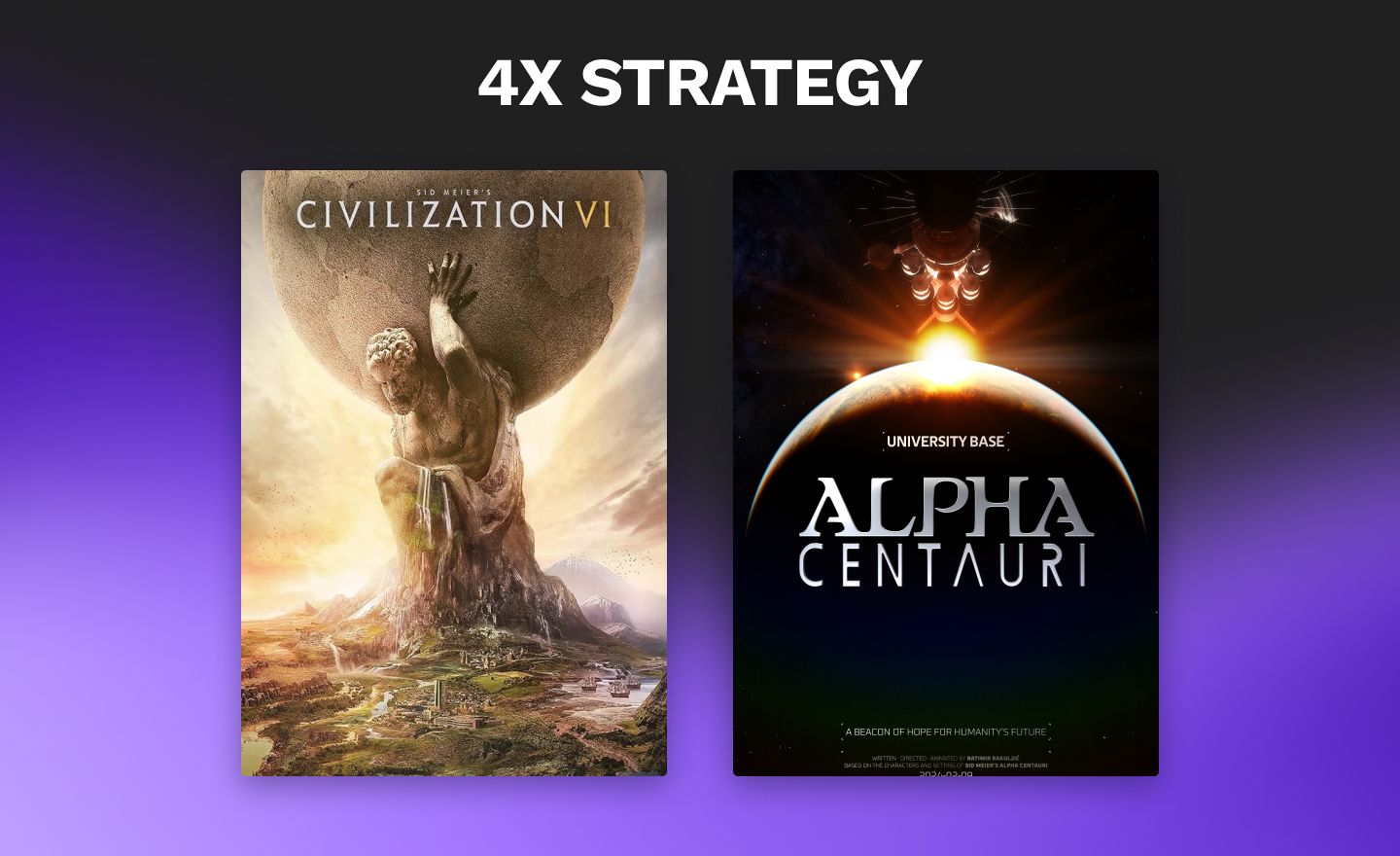
This is a subgenre of strategy games. The peculiar name “4X strategies” defines the gameplay: in such titles, a player controls an empire and focuses on the four Xs — eXplore, eXpand, eXploit, and eXterminate. Such games often have a focus on deep resource management and long-term planning.
As for the examples — several of them are other legendary titles, such as Civilization and Sid Meier's Alpha Centauri.
Turn-based card games
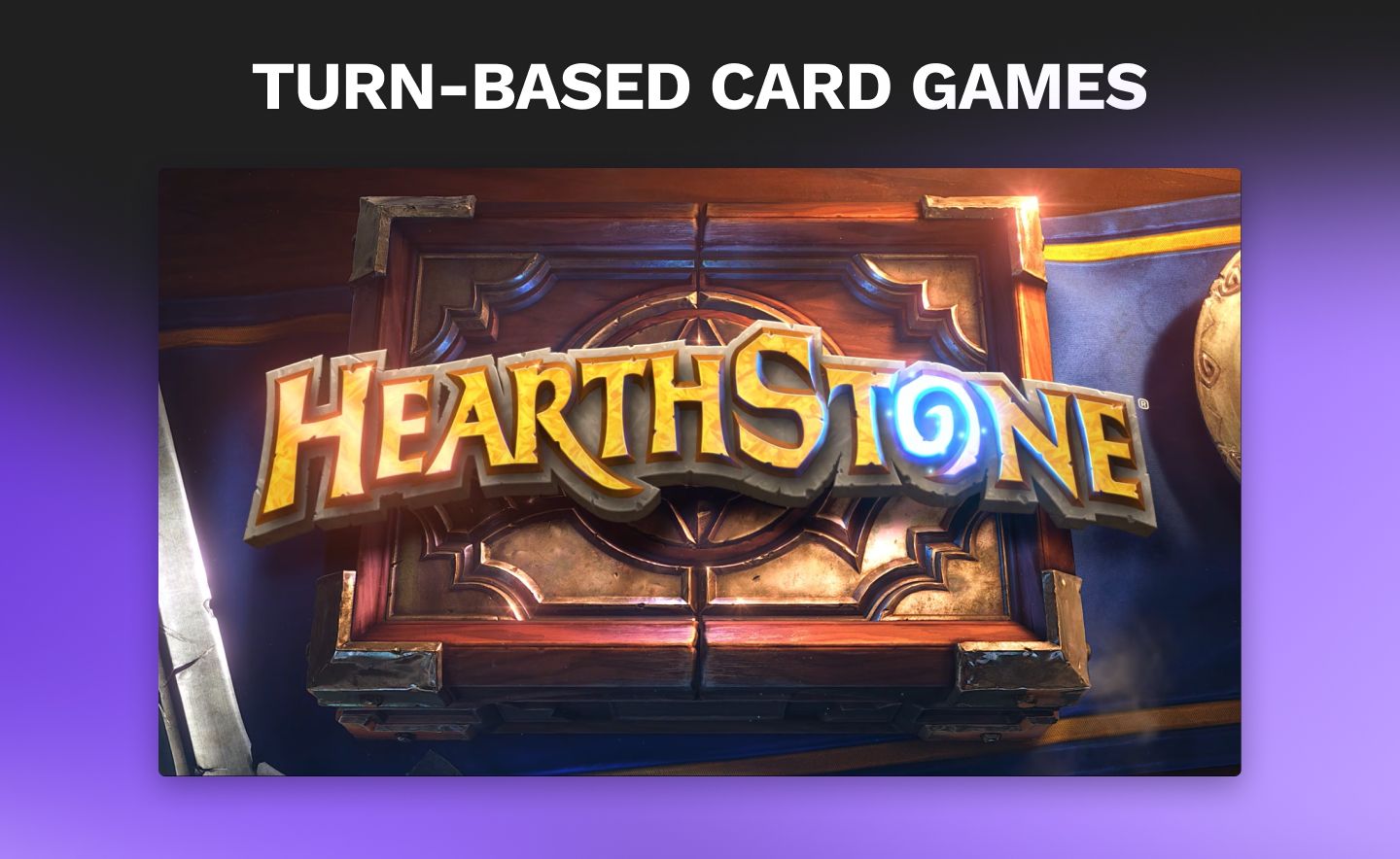
Some might say there's nothing thrilling in playing a game using decks of cards, especially with so many diverse and graphically advanced titles out there. However, good old turn-based card games are still as relevant and popular as before. They typically focus on strategic deck building and allow players to plan their moves and play with other combatants at a slow, comfortable pace.
Probably the most well-known example of such titles these days is Hearthstone — a digital card game based on the Warcraft universe.
Turn-based sport games
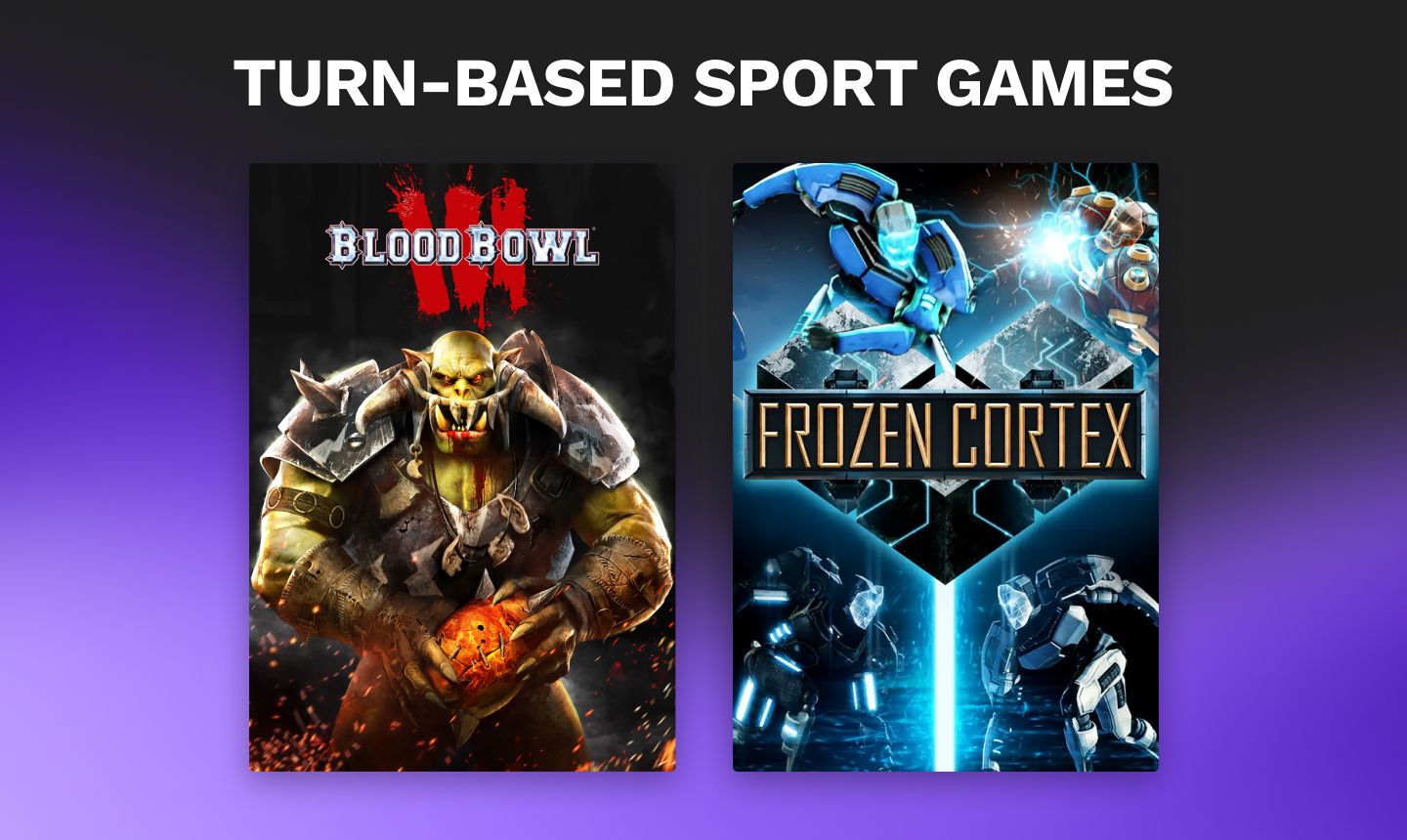
Those looking for something more dynamic than a card game but still enjoying strategic planning and turn-based gameplay can try out these games. Turn-based sports games add some real-time action to the strategy dynamics and allow players to dive deeper into the world of their favorite sport.
Titles like Frozen Cortex and the Blood Bowl series are vivid examples of such games.
Turn-based puzzle games
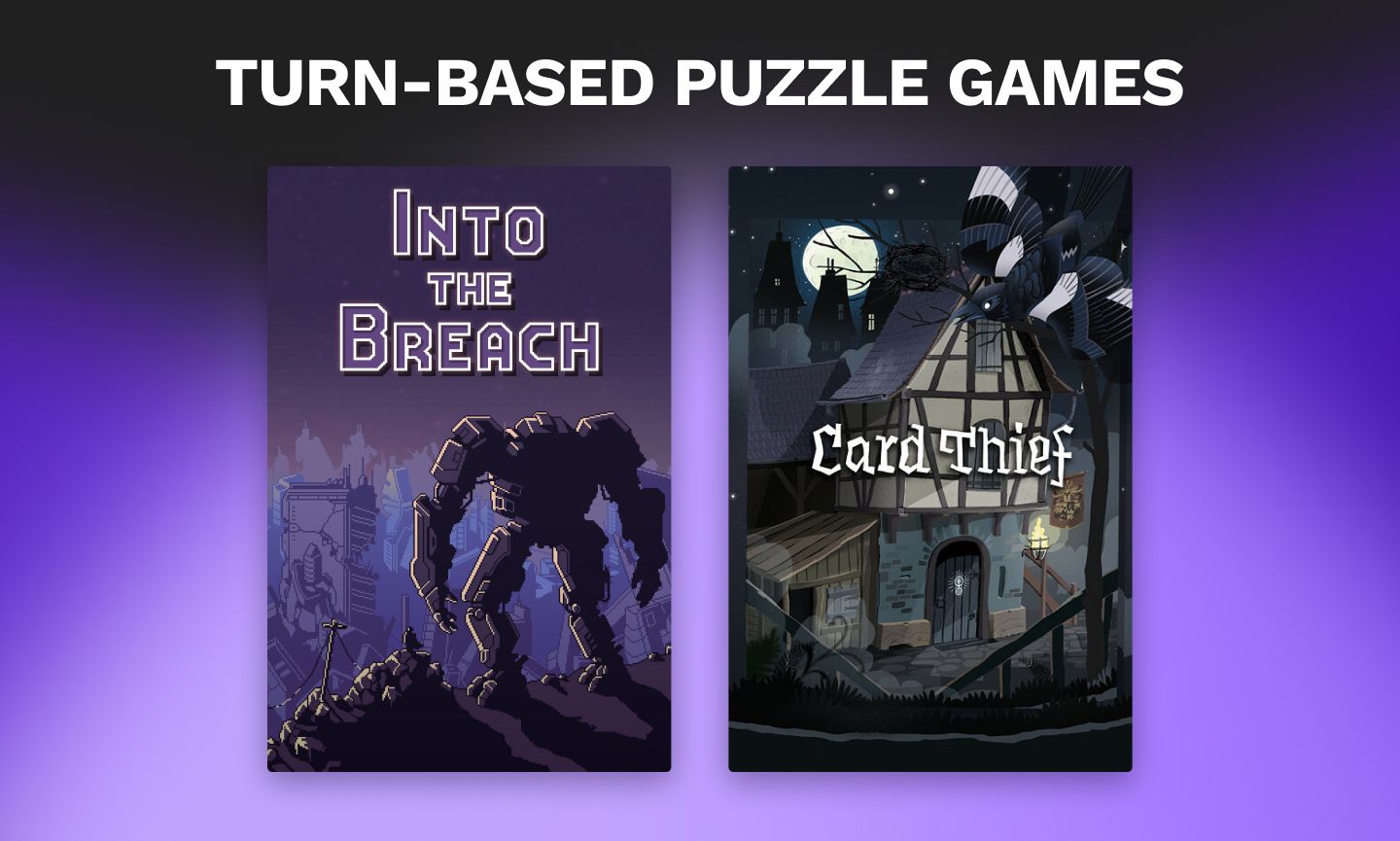
Puzzle enthusiasts might enjoy the transfer of their favorite activity to PCs and mobile devices. These games require players to solve puzzles within a turn-based framework. They'll need to utilize strategic thinking and planning to succeed in this subgenre.
If you’re curious about examples of such games, check out Into the Breach and Card Thief titles.
As you can see, the turn-based genres are very diverse. Each game type can offer players a different yet nonetheless captivating gameplay experience and allow them to utilize their strategic thinking.
Step-by-step process for developing a turn-based game
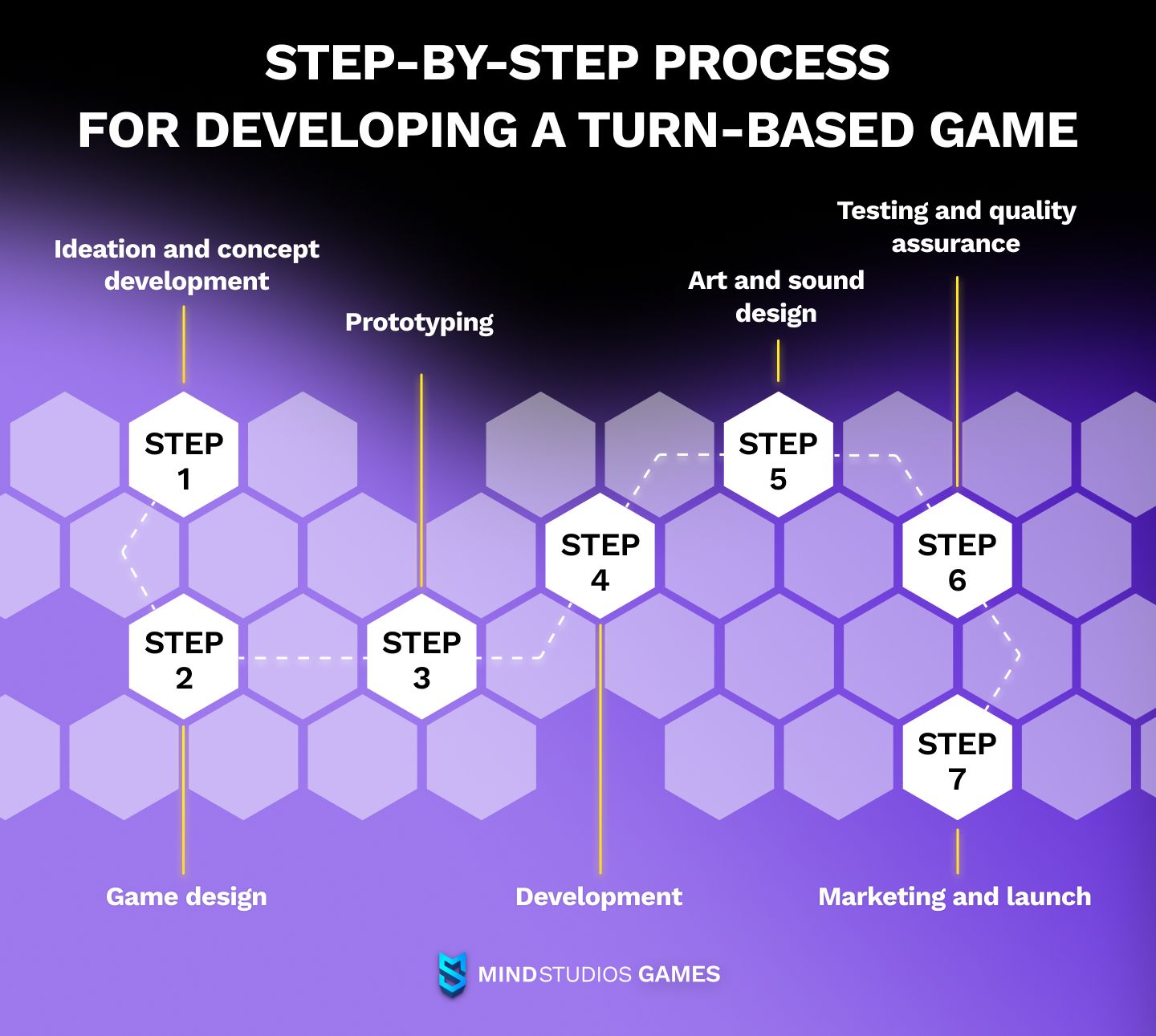
Now that you've got acquainted with the genres and their diversity, you might find yourself wondering how to make a turn-based strategy game. The process of creating turn-based games is quite similar to traditional game development and consists of the following steps.
Step 1: Ideation and concept development
At this point, you need to define your game's vision. Start with figuring out what exactly you want to create — it could be a turn-based survival game or a puzzle one, or a card one.
Figure out the following things about your future game:
- Genre
- Theme or main concept
- Key gameplay elements
- Target audience (their interests, gaming preferences, and age group — the last one isn't necessary but can be useful for cultural and pop-cultural references)
- Unique selling points
Obviously, no development process should skip the research part. Research helps you validate your theories before implementing them into life and ensures that you'll spend your time and resources creating something that the market truly needs.
To develop a turn-based game, study the successful titles in the market. Evaluate their strengths and weaknesses, and spot things about them that players enjoy the most. At this stage, you can explore all turn-based games you like, but the next step would be focusing on your potential competitors exclusively. Analyze their games to identify the gaps or opportunities your game could fill. It could also be useful to talk to potential players (for instance, on game forums) to gain insights about what they like and what they lack in current titles.
Step 2: Game design
To ensure the efficiency of your turn-based game design development, you need to create a game design document (GDD) first. This document is basically a blueprint for your game that defines and details every of its essential aspects, from story to gameplay mechanics.
GDD usually includes the following sections:
- Game overview. It consists of a detailed summary that outlines the game genre, target audience, and unique selling points.
- Story and characters. This section includes a thorough description of the game's narrative, stories of each character, and their development during the game.
- Gameplay mechanics. Rules, systems, and other core gameplay features are all included in this section.
- Levels. This section contains a detailed description of each of the game's levels, including their layout and design principles.
- Assets. These are things like art style, 2D or 3D visual themes, sound effects, and music.
Another thing essential for turn-based game development is gameplay mechanics. You need to define it in this stage, starting with the combat system: how it will work, what will it include, how the turns will happen, etc.
It's also important to outline:
- the character progression: how they'll level up, gain new abilities, and improve existing ones
- resource management: how health, mana, game currency, and equipment will be managed
- user interface (UI): how the interface will look and how intuitive it would be
The level design also takes place at this step. You need to plan the layout and flow of each level, ensuring that they will become more and more complex as the game unrolls. You also need to create diverse and visually appealing environments that will support the game's narrative and add various interactive elements that can help make the game more interesting.
Step 3: Prototyping
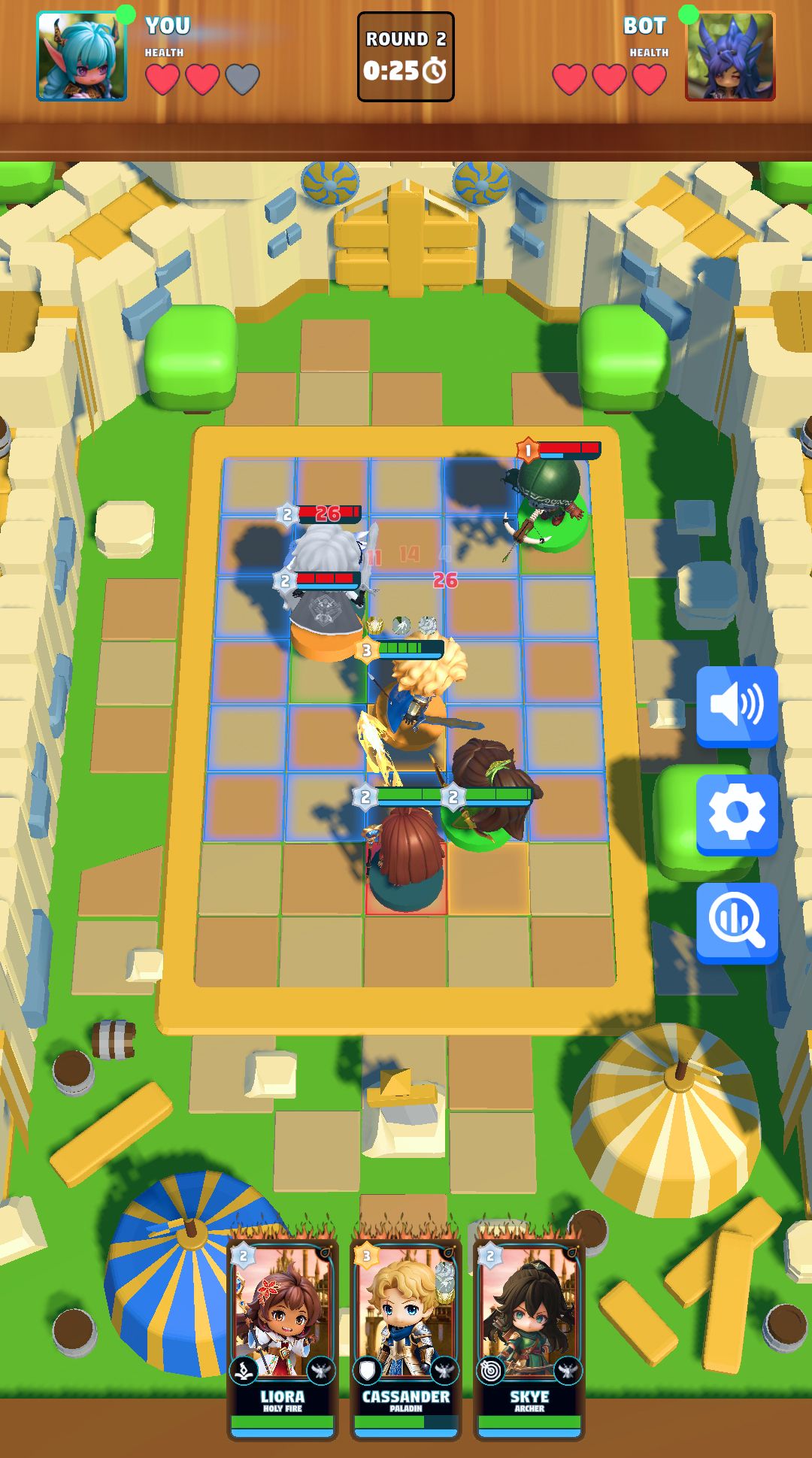
Prototype image for a game by our partners, Dim Sum Games
Turn-based game prototyping all starts with building a simple, basic version of your title. At this step, you just need to test its core mechanics and concepts to see if they are engaging and work as expected. Start by implementing the essential gameplay elements: movement, combat, and turn order.
Then add primary systems like health management, action points, and basic artificial intelligence (AI) for enemies. Create a minimal version of the player's interface that still allows users to interact with the game's core mechanics. You can use game development tools and engines like Unity, Unreal Engine, or Godot to quickly build and iterate on your prototype.
Once a prototype is assembled, it's time to move to the testing phase. Testing a title at this stage allows you to identify obvious bugs and issues, ensure that core mechanics work as intended without suffering from major glitches, and check if the gameplay is balanced. What's more, it allows you to save time, resources, and money, as you'll be able to spot and fix errors quickly, even before the game gets more complex.
After the development team finishes testing, gather feedback from a small group of external testers who represent your target audience. They can help you figure out if the game is easy for new players to understand and if the core gameplay is engaging and fun.
Step 4: Development
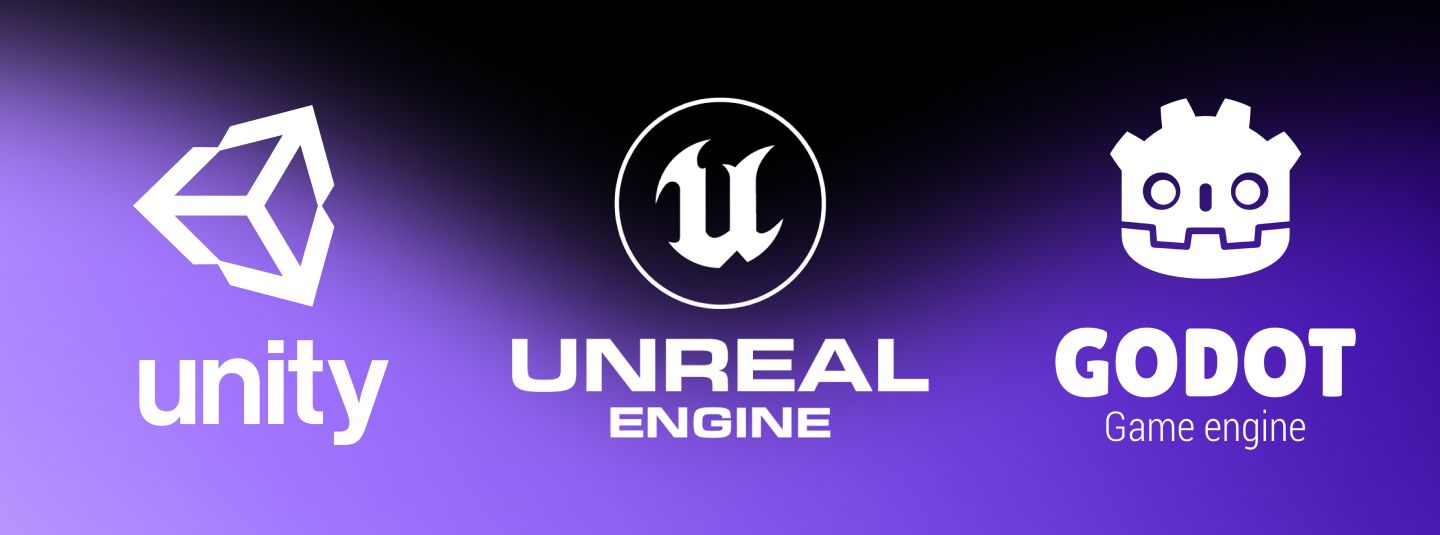
Now it's time to move to the turn based game development process. It starts with choosing the right tools and technologies, the game engine in particular.
The most popular game engine options are:
- Unity. It is great for 2D and 3D games, widely used (which means you won't struggle with finding developers who work with it), and has an extensive asset store.
- Unreal Engine. It is a more complex option that suits complicated 3D games and allows creating high-end graphics.
- Godot. It's an open-source game engine, which is lightweight and good for both 2D and 3D.
One of the game development best practices is to work in iterative cycles, focusing on small, manageable tasks. You can achieve this by breaking down the development process into sprints (for instance, 2-week periods, with specific goals).
During these sprints, implement features according to the turn-based game design document, regularly test new features to ensure they work correctly, and integrate them within the existing systems.
Set development milestones to track progress and keep the project on schedule. You should also conduct regular reviews to assess progress, gather feedback, and make necessary adjustments.
Step 5: Art and sound design
The next step in creating turn-based games is the development of visual assets. While the process might differ for 2D and 3D video games, it all starts the same — with concept art.
The goal of concept art is to establish the visual style and tone of the game. While it might seem that it's the characters that draw most of the players' attention, environments and other key objects (such as weapons or minions) can also be very important parts of the concept art, especially if your game has a unique atmosphere.
At this stage, focus on making the game settings diverse and immersive, and make sure that the visuals align with the game's narrative and gameplay. You can also draft and design user interface elements such as menus, health bars, action buttons, and inventory screens. These elements have to be both visually consistent with the rest of the game and easy to understand.
Sound and music also play a critical role. To make the game even more atmospheric and appealing, focus on the following things:
| Sound effects (SFX) | Sounds for various in-game actions, including character movements, combat, environment sounds, and UI interactions. These effects can be created or sourced. |
| Music | It should fit the mood and tone of the game. Don't forget about the main theme of your title that describes the game's overall feel and is often used in trailers and other marketing materials. |
| Voice actors | We know lots of games, including Detroit: Become Human, and Baldur's Gate 3 that wildly succeeded because of many things, sound actors included. So if your game includes dialogue, consider hiring voice actors to bring characters to life. |
Step 6: Testing and quality assurance
Once your game is built, it's time to test it once again. Even if you've done it throughout the process, this stage of testing is still crucial. Even the AAA tiles such as Cyberpunk 2077 had experienced unsuccessful releases due to the major number of bugs missed during the testing.
To ensure that your testing and quality assurance strategies will deliver the most efficient results, consider the following best practices:
- Develop a detailed test plan. It should outline the scope, objectives, resources, schedule, and types of testing that will be conducted.
- Write test cases that cover all aspects of the game, from basic functionality to more complex details.
- Use automated testing tools for repetitive tasks. This can help you save time and reduce the chances of human error.
- Implement a bug tracking system (such as Jira) to log and manage all the bugs. Ensure that your testers provide detailed descriptions of each bug, including screenshots, severity level, and other essential factors.
- Test your title with different groups of players to gather ongoing feedback and catch new issues.
- Keep in mind that no matter how much effort you've invested in testing, chances are that you still might need to fix some bugs after the game's launch. Therefore, continue monitoring the players' feedback and react to it swiftly.
Step 7: Marketing and launch
Even when the turn-based game development is finished and the testing is complete, your work doesn't stop. To ensure that the target audience will anticipate and enjoy your title, you need to market it well.
Most likely, at this point, you already have a detailed picture of your target audience. You need to keep it in mind while building and tailoring your marketing strategy. At this step, you also need to develop a strong brand identity for your game. This could be done at the same time as the development to speed up the delivery.
You can also share the development process, its challenges, and milestones in your developer blogs and posts and distribute press releases to gaming news websites and influencers. This helps you to get people interested even before the release.
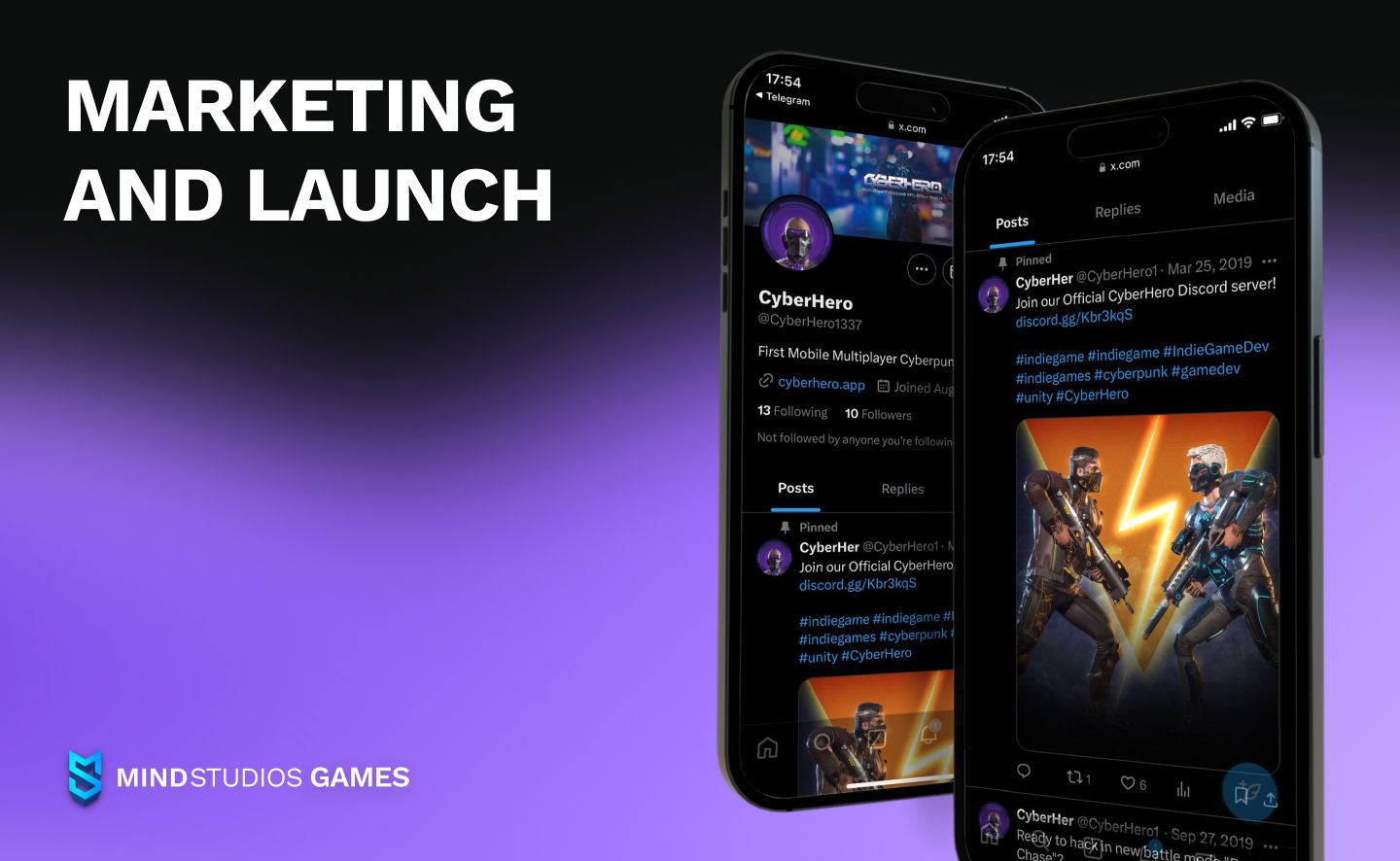
CyberHero: A Multiplayer Cyberpunk RPG Shooter developed by Mind Studios
A community is also important, and you can start building it even before the title is finished. Engage with potential players on social media, forums, and your game's website, and ask them to participate in beta testing — all of this will allow you to build word-of-mouth excitement.
As for the release, here's what our team recommends keeping in mind:
- Ensure that your game's website and store pages are fully optimized. They need to have engaging descriptions, high-quality images, and videos.
- Prepare a press kit with essential information about the game. Such a kit can include a fact sheet, high-resolution visuals, and contact details.
- Consider hosting a live stream with the community on the launch day.
- You can also run targeted ads and social media posts to announce the game's release, build anticipation, and encourage downloads.
- And don't forget about the post-launch support — it should be excellent to build the audience's loyalty and keep them engaged.
Challenges of turn-based game development
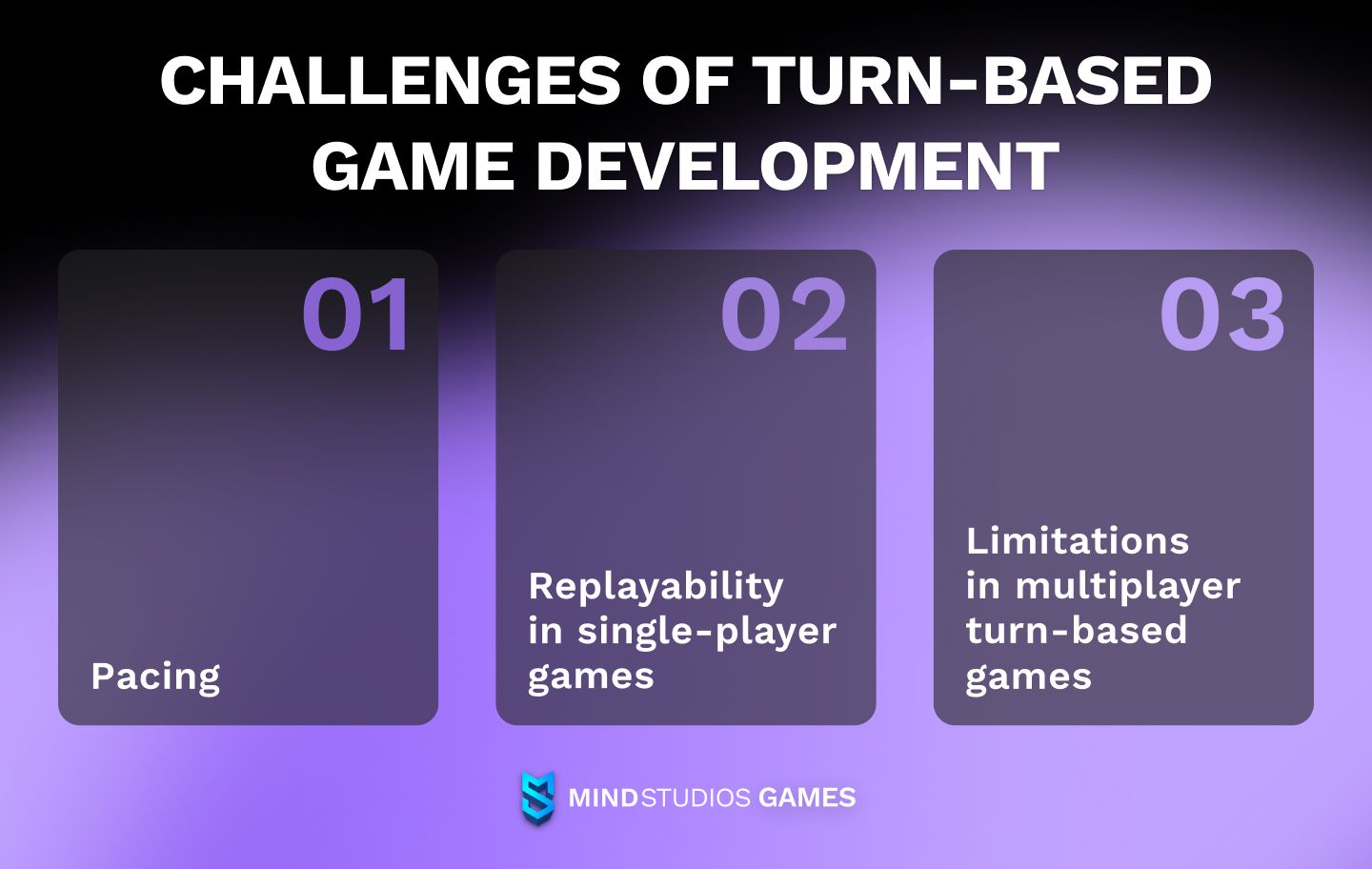
In a niche this complex, there are bound to be stumble blocks. Here’s what we know about them and what we can do to not stumble.
Pacing
This is a challenge for game designers. Unlike with real-time games, which force players to take action, in turn-based games, it’s impossible to predict when the player will advance. It’s a feature many fans of turn-based games like — an opportunity to take their time and think things through. But for a game designer, it makes things a bit harder, especially when designing the first stages, where players lack resources or battle units (if it’s a game with a battle mode).
How to overcome this: We usually take extra care with balancing the pacing in turn-based games. First stages shouldn’t be too much from the get-go, so we make them somewhat similar to onboarding. As the players get used to mechanics, we gradually change the pacing to keep things interesting.
Replayability in single-player games
Replayability is a tough nut to crack in story-driven games, both real-time and turn-based, but for turn-based games, it’s an issue even if the game is not story-driven. If you want players to replay your single-player turn-based game, you’ll need to put effort into it not being repetitive, as players will get bored competing with the same algorithm time and again.
How to overcome this: Design algorithms with variables in actions. The opponents players face need to change tactics, skill sets, or opponents can just be random. One of the ways to do that is to employ artificial intelligence. However, even without AI, developers can make code with variables.
And if your game does rely on the story at least in part, the story should also have variability — if not a complete one with different ending, then at least with branching events triggered by certain choices.
Limitations in multiplayer turn-based games
The biggest perk of turn-based games for many players is the opportunity to take your time deciding on your next move. However, when the game is multiplayer, that can get tricky. A human opponent on the other side of the screen won’t want to wait forever for your move. Game designers need to keep that in mind when developing turn-based multiplayer games.
How to overcome this: Set time limits for turns and/or limits on how many turns can players take for a win. However, we caution developers to do thorough research when making these decisions. Players vary greatly in habits, playing styles, and personal circumstances, and perfect limits are hard to pinpoint.
P.S. There’s a lifehack possible in multiplayer turn-based games, where players can take a while to make a move. You can allow for simultaneous matches. By offering players to play several games at the same time, you can offer longer time limits. It’s not a perfect solution (a fast-acting player might stumble upon several slow-acting ones and get stuck), but it’s an option.
Case studies from Mind Studios Games
Mind Studios Games provides development services to the yet-to-launch Rise of Realms game, a 4X strategy set in a fantasy world, with RPG elements and simulated battles. The game is still a work-in-progress, but we can give away a little spoiler: there will be dragons, goblins, and a lush fantasy environment 🤩 Check out this WIP screenshot we’ve got:
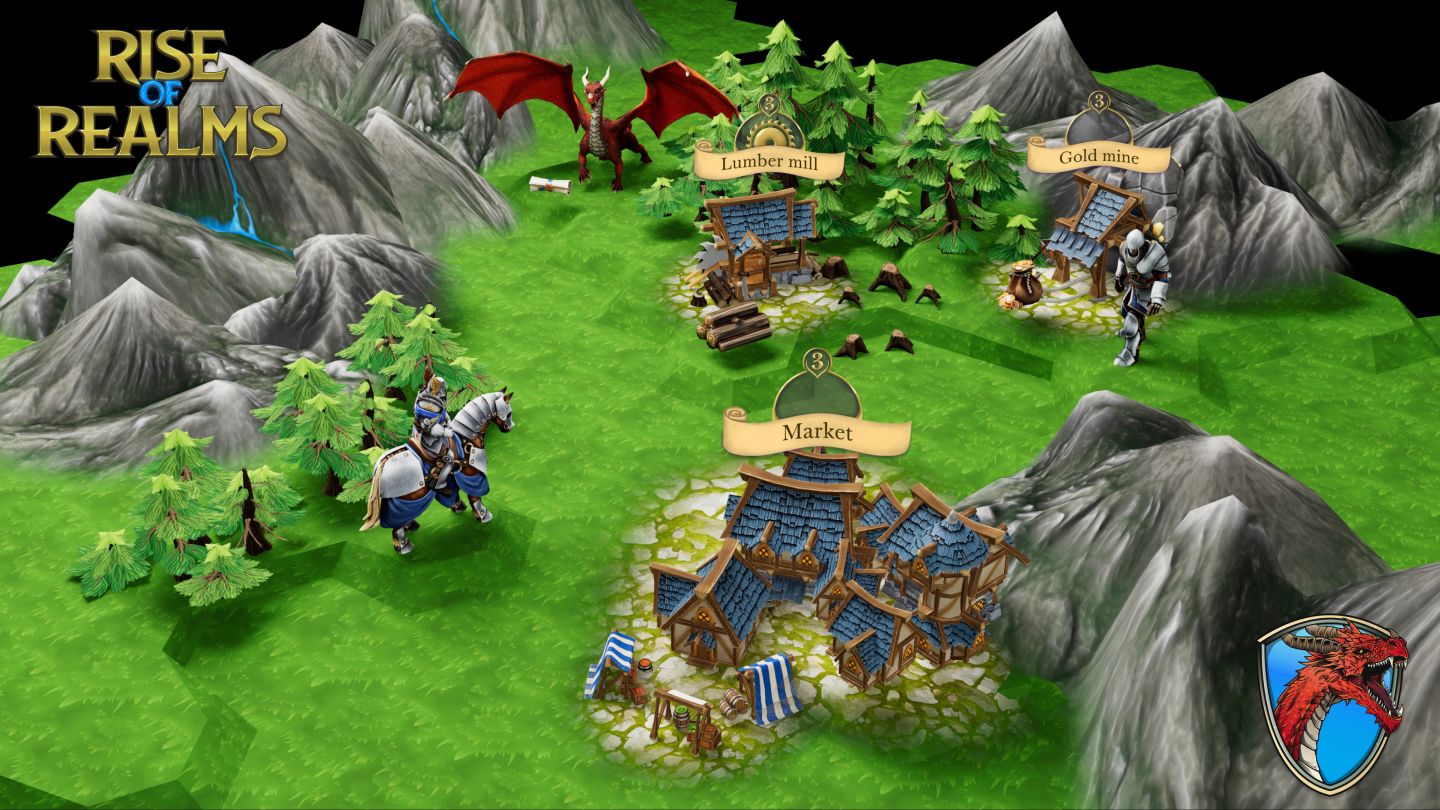
Rise of Realms, a 4X strategy game Mind Studios Games is participating in working on with Goat Works.
Another title we’ve been working on recently is an ambitious game project led by Derek Winder and Albert Kwong from Dim Sum Games, two people who previously worked at Riot Games. It’s an auto-battler, where players have six anime chibi style heroes they can put on the game board to autonomously battle the opponent’s characters.
Each character in the game has unique abilities, class, and personal history. All these parameters will affect the synergy between characters and, consequently, the players’ strategy. The goal is to accumulate points, which are granted for victory and for each surviving character after the battle.
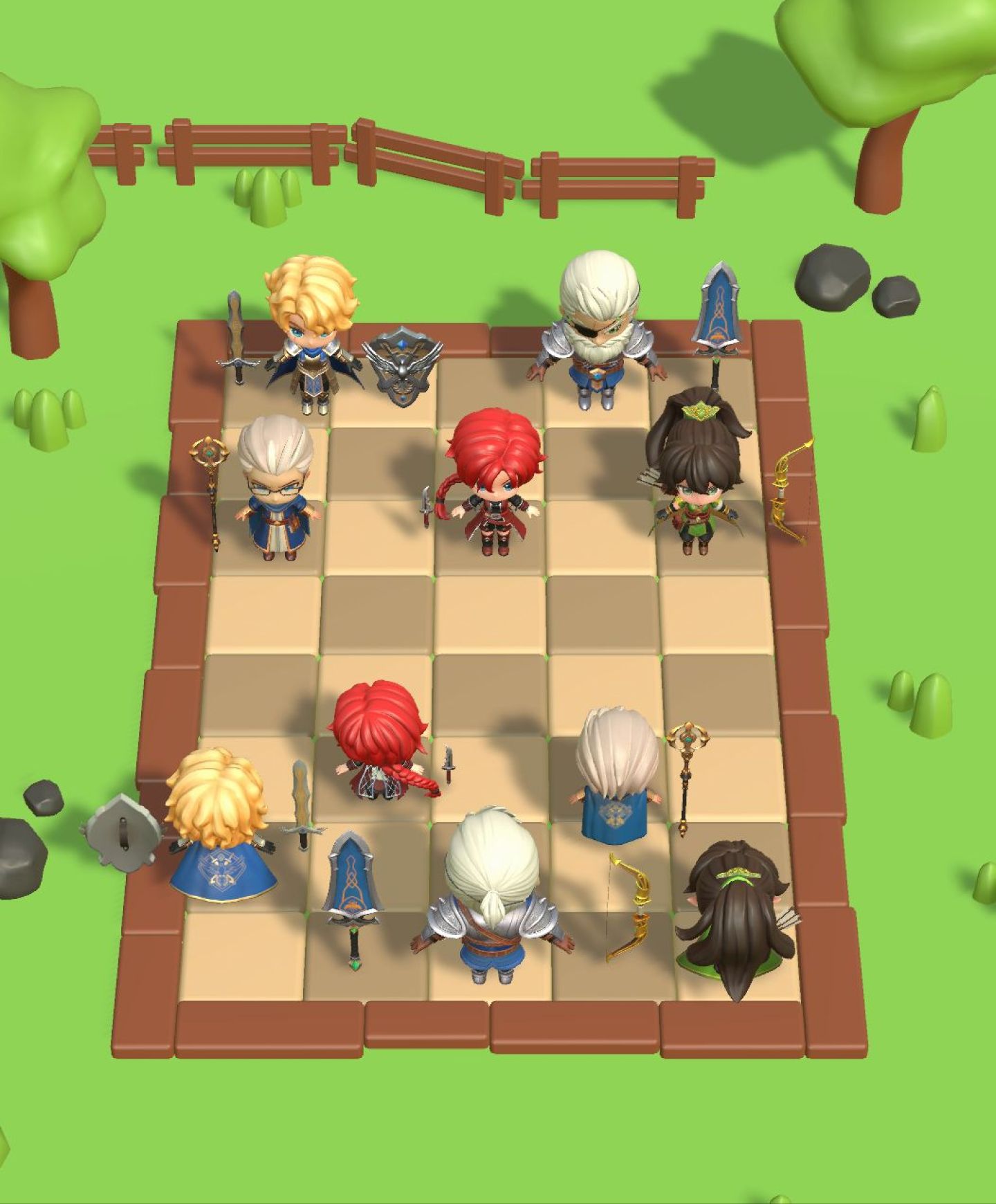
WIP auto-battler turn-based game Mind Studios Games is participating in.
Conclusion
Nimble fingers and split-second decision-making necessary for real-time games are often associated with professional or just really passionate gamers. But games for different kinds of talents also exist.
The unique offer of a turn-based game — where players can maintain their own pace even when competing with others or battling NPC opponents — will hardly lose its appeal to gamers. Ever. For that reason, there won’t be a time when turn based game development stops being in demand.
We at Mind Studios Games are onboard with this trend. We’re really happy to be working on this type of games, and we’ll jump at the opportunity to further dive into it. If you’re looking for a partner to entrust your idea for a turn-based game — of any genre! — reach out to us for a free consultation and a rough quote.

